Get free scan and check if your device is infected.
Remove it nowTo use full-featured product, you have to purchase a license for Combo Cleaner. Seven days free trial available. Combo Cleaner is owned and operated by RCS LT, the parent company of PCRisk.com.
What is IS ransomware?
IS (also known as Ordinypt) ransomware was discovered by dnwls0719 and is a malicious program that prevents victims from accessing their files by encoding them with a strong encryption algorithm. To recover their files, victims are encouraged to pay a ransom to the cyber criminals.
IS adds a random extension to the filenames of all encrypted files. For example, "1.jpg" might become "1.jpg.KRk5p". Instructions about how to pay the ransom are provided in the "KRk5p_how_to_decrypt.txt" text file. The name of this file is associated with the extension of encrypted files.
To purchase decryption software, victims must to use the Tor browser and open the link, which is provided in the ransom message. On the Tor website, victims must enter an access code that can also be found in the ransom message.
The Tor website then opens another page, which displays a countdown timer giving the time remaining within which victims must pay the ransom. When this time elapses, decryption keys are deleted and victims will no longer be able to decrypt their files or purchase a decryption key.
The cost of decryption software and keys is $1,500 and must be paid in a cryptocurrency (Bitcoins). Cyber criminals assure victims that they will send decryption tools after payment is made, and that no other party can provide these tools.
Unfortunately, the second part is accurate: most ransomware-type programs lock files using strong encryption algorithms and it is impossible to decrypt encrypted files without specific tools held only by the cyber criminals who designed the ransomware.
Note, however, that cyber criminals often do not send these tools even after payment, and people who trust them are scammed. Typically, the only way to recover files free of charge (and without having to contact and/or pay ransomware developers) is to restore them from a backup.
Screenshot of a message encouraging users to pay a ransom to decrypt their compromised data:
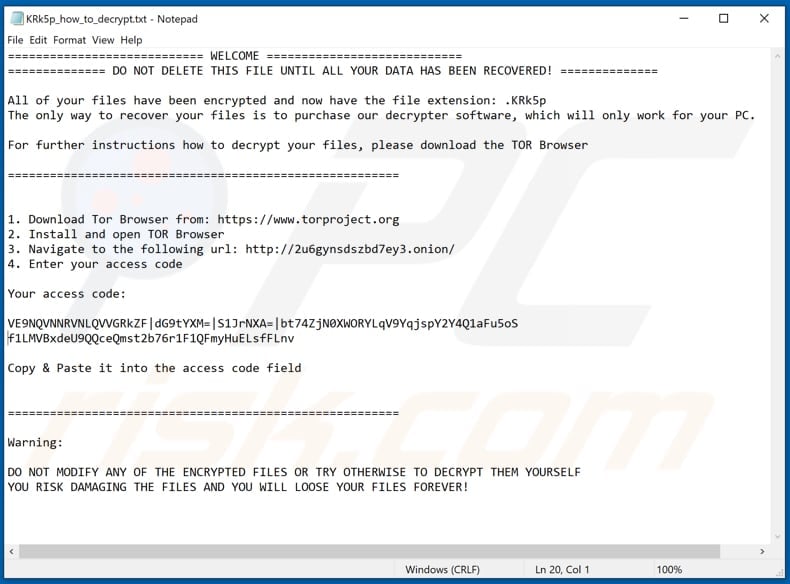
IS ransomware is similar to other programs of this type. Other examples are Hermes837, Guarded, and NextPharma. In most cases, these programs encrypt files using cryptographic algorithms (symmetric or asymmetric) and create ransom messages that contain instructions about how to pay the ransom.
Common differences are algorithms used for encryption and size of ransom. In any case, it is often impossible to decrypt files without the involvement of cyber criminals, unless ransomware is not finished (has bugs, flaws, etc.). Therefore, have your data backed up and store it on a remote server (Cloud) and/or unplugged storage device.
How did ransomware infect my computer?
Typically, cyber criminals proliferate ransomware (and other malware) through spam campaigns, dubious download channels/tools, Trojans, unofficial software updating and/or activation tools. They often send emails that contain attached files (or links) and hope that at least some of the recipients open them.
If opened, these files then install malware. Typically, they send Microsoft Office documents, PDF documents, executable files (.exe), JavaScript files, and archives such as ZIP, RAR, etc. Malware is also spread using untrustworthy file or software download channels.
Examples of such channels/tools are Peer-to-Peer networks (torrent clients, eMule, and so on), unofficial pages, third party downloaders, freeware and free file hosting pages. People who download files using them risk downloading malicious files. If opened (executed), these install high-risk malware.
Typically, cyber criminals disguise these files as harmless and legitimate. A Trojan is malicious software that usually causes chain infections. Therefore, if a computer is infected with a Trojan, it becomes infected with additional malware.
Unofficial (third party) updaters are often designed to install malicious software rather than updating legitimate installed software, or they exploit bugs, flaws of outdated software installed on the system.
Unofficial software activation ('cracking') tools are used by people who seek to avoid paying for licensed software, however, they are often designed to proliferate malware - people who use them end up installing malicious programs.
| Name | IS (Ordinypt) virus |
| Threat Type | Ransomware, Crypto Virus, Files locker. |
| Encrypted Files Extension | .KRk5p (IS appoints a different random extension each time). |
| Ransom Demanding Message | KRk5p_how_to_decrypt.txt (its name can vary). |
| Ransom Amount | $1500 in Bitcoin |
| Cyber Criminals Cryptowallet Address | 1LoteKdmxF17SVvP7MnvbrTRjTM7JH8dUV (Bitcoin) |
| Detection Names | Avast (Win32:Trojan-gen), BitDefender (Trojan.GenericKD.32440367), ESET-NOD32 (A Variant Of Win32/Kryptik.GWKD), Kaspersky (Trojan.Win32.Yakes.zanc), Full List Of Detections (VirusTotal) |
| Rogue Process Name | Xmlschemeaxmlcl Incidences Video Atop Validatthe (it can vary) |
| Symptoms | Cannot open files stored on your computer, previously functional files now have a different extension (for example, my.docx.locked). A ransom demand message is displayed on your desktop. Cyber criminals demand payment of a ransom (usually in bitcoins) to unlock your files. |
| Additional Information | Ransom must be paid through a Tor browser. |
| Distribution methods | Infected email attachments (macros), torrent websites, malicious ads. |
| Damage | All files are encrypted and cannot be opened without paying a ransom. Additional password-stealing trojans and malware infections can be installed together with a ransomware infection. |
| Malware Removal (Windows) |
To eliminate possible malware infections, scan your computer with legitimate antivirus software. Our security researchers recommend using Combo Cleaner. Download Combo CleanerTo use full-featured product, you have to purchase a license for Combo Cleaner. 7 days free trial available. Combo Cleaner is owned and operated by RCS LT, the parent company of PCRisk.com. |
How to protect yourself from ransomware infections?
Avoid opening files that are attached to irrelevant emails, especially when they are sent from unknown, suspicious addresses. Typically, cyber criminals disguise such emails as official, important, legitimate, and so on. All installed software should be downloaded from official websites and using direct download links.
None of the other tools/sources mentioned above are safe to use. Software 'cracking' tools and unofficial, fake software updaters often download and install malicious programs rather than activating or updating installed software or operating systems.
Furthermore, unofficial activation tools are illegal. Have a reputable anti-virus or anti-spyware tool installed and scan the system with it regularly. If your computer is already infected with IS, we recommend running a scan with Combo Cleaner Antivirus for Windows to automatically eliminate this ransomware.
Text presented in IS ransomware text file ("KRk5p_how_to_decrypt.txt"):
============== WELCOME =============
============== DO NOT DELETE THIS FILE UNTIL ALL YOUR DATA HAS BEEN RECOVERED! ==============All of your files have been encrypted and now have the file extension: .fYHJH
The only way to recover your files is to purchase our decrypter software, which will only work for your PC.For further instructions how to decrypt your files, please download the TOR Browser
==========================
1. Download Tor Browser from: https://www.torproject.org
2. Install and open TOR Browser
3. Navigate to the following url: http://2u6gynsdszbd7ey3.onion/
4. Enter your access codeYour access code:
-
Copy & Paste it into the access code field
==========================Warning:
DO NOT MODIFY ANY OF THE ENCRYPTED FILES OR TRY OTHERWISE TO DECRYPT THEM YOURSELF
YOU RISK DAMAGING THE FILES AND YOU WILL LOOSE YOUR FILES FOREVER!
Screenshot of first Tor page:
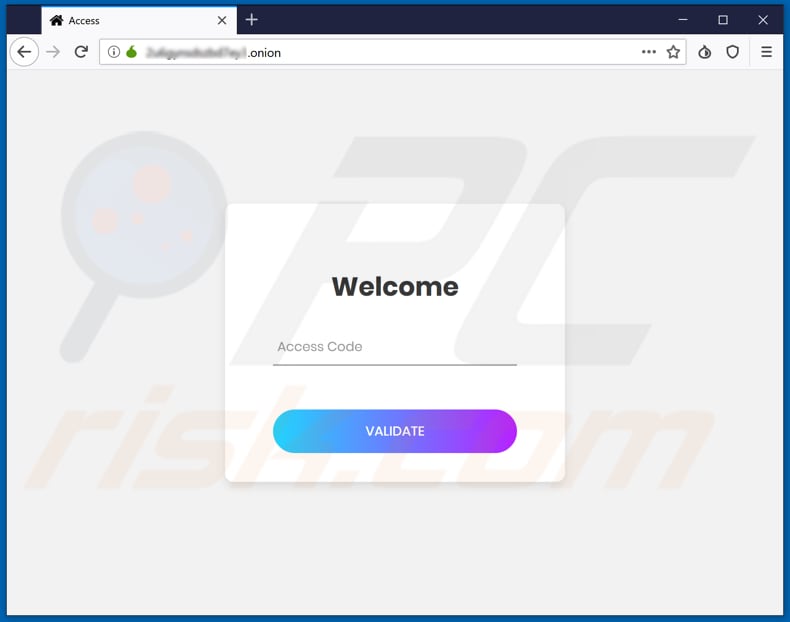
Screenshot of second Tor page:
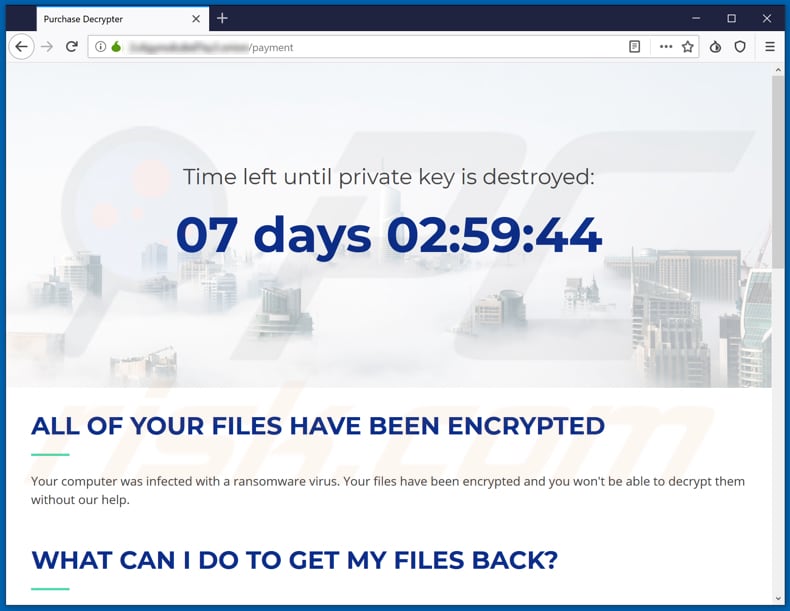
Text presented within this site:
All of your files have been encrypted
Your computer was infected with a ransomware virus. Your files have been encrypted and you won't be able to decrypt them without our help.
What can I do to get my files back?
You can buy our special decryption software, this software will allow you to recover all of your data and remove the ransomware from your computer. The price for the software is $1,500. Payment can be made in Bitcoin only.
What happens when the timer runs out?
The private key that is required to recover your files will be deleted from our servers and your files will be lost forever!
What guarantees do I have?
There's no guarantees, but this is our business, it would be bad for our business if we do not stick to our word. We assure you, you will be able to decrypt all of your files after payment. The only guarantee we give you is that you WILL NOT be able to recover your files without our help.
How do I pay, where do I get Bitcoin?
Purchasing Bitcoin varies from country to country, you are best advised to do a quick google search yourself to find out how to buy Bitcoin. Many of our customers have reported these sites to be fast and reliable:
Coinmama - hxxps://www.coinmama.com Bitpanda - hxxps://www.bitpanda.com
Payment informationAmount:
0.1473766 BTC
Address:
1LoteKdmxF17SVvP7MnvbrTRjTM7JH8dUV
The decrypter will become available for download once your transfer has received 2 confirmations on the Bitcoin network.
Appearance of Tor website in GIF:
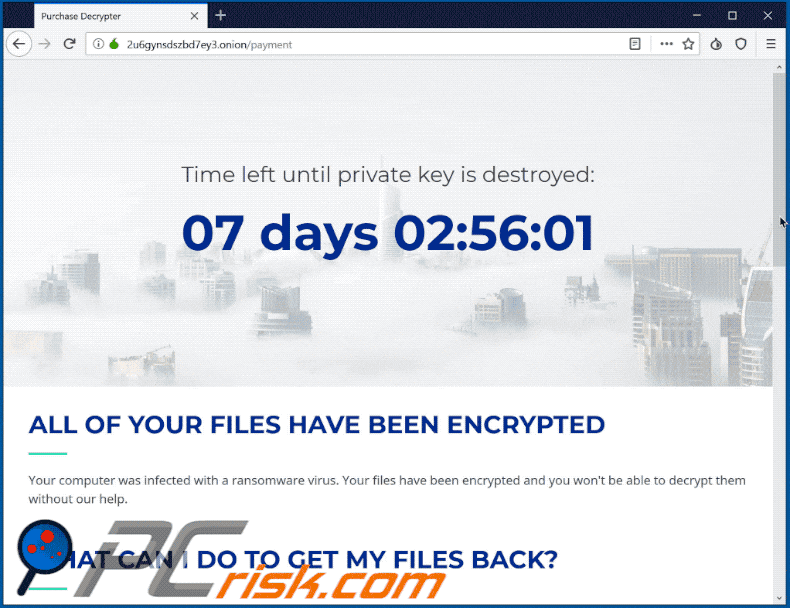
Screenshot of files encrypted by IS (".KRk5p" extension - this ransomware appoints different extensions each time).
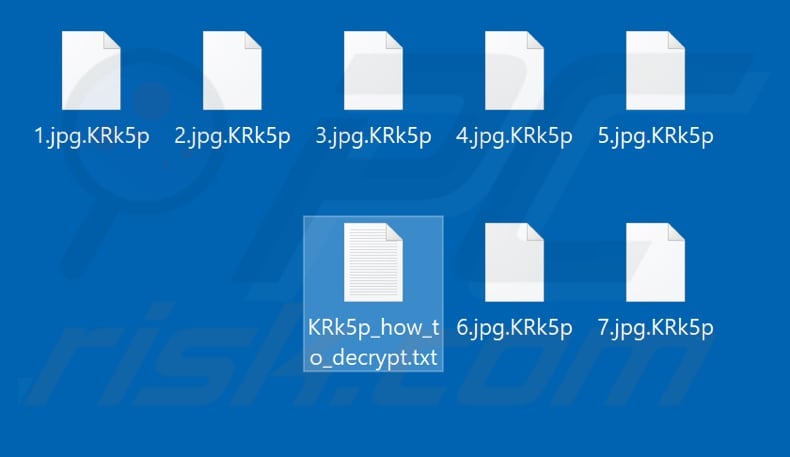
Malicious IS ransomware process in Task Manager ("Xmlschemeaxmlcl Incidences Video Atop Validatthe"):
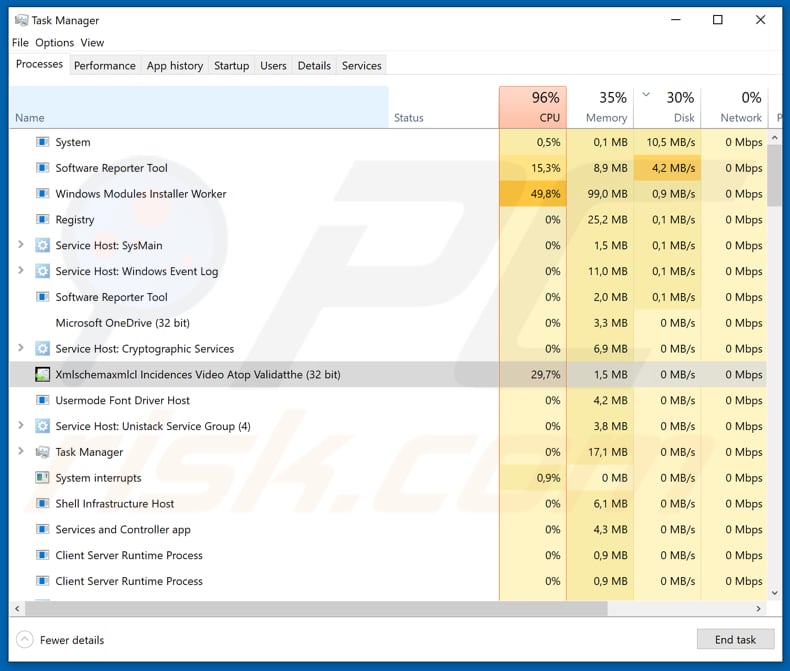
Update September 17, 2019 - A new spam email campaign currently targeting German-speaking users and spreading IS (Ordinypt) ransomware has recently been discovered. The spam emails are presented as job applications from a woman who claims to be Eva Ritcher.
Emails consist of German text and two attachments: Eva's picture (actually, a random stock photo of a woman) and an archive, which contains a malicious executable presented as Eva's resume in PDF format.
At time of research, attachments were named "Eva Ritcher Bewerbungsfoto.jpg" and "Eva Richert Bewerbung and Lebenslauf.zip" (the executable within is named "Eva Richter Bewerbung und Lebenslauf.pdf.exe"), however, these filenames might vary.
Screenshot of a malicious email presented as Eva Ritcher's job application:
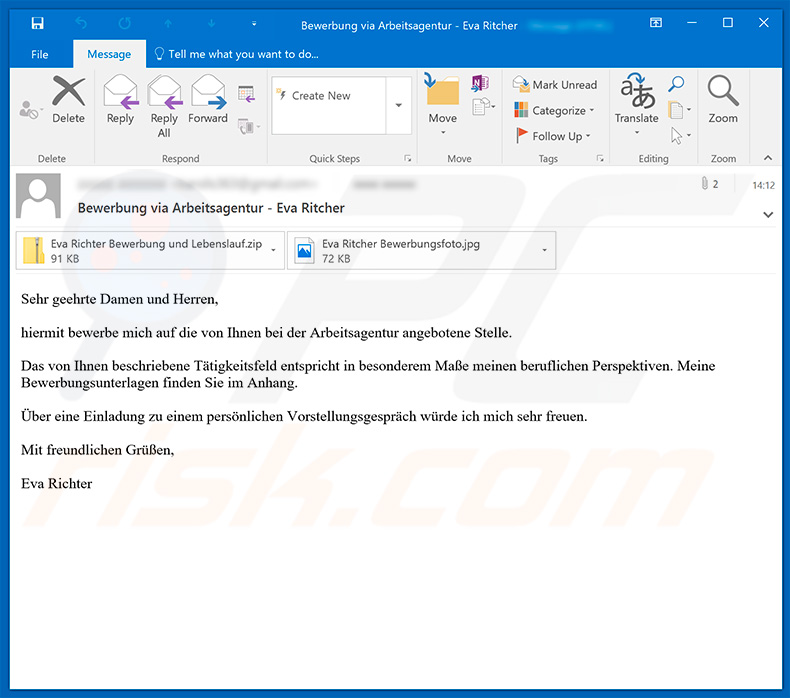
Text presented within this email:
Subject: Bewerbung via Arbeitsagentur - Eva Ritcher
Attachments: Eva Ritcher Bewerbungsfoto.jpg, Eva Richert Bewerbung and Lebenslauf.zip
Sehr geehrte Damen und Herren,
hiermit bewerbe mich auf die von Ihnen bei der Arbeitsagentur angebotene Stelle.
Das von Ihnen beschriebene Tätigkeitsfeld entspricht in besonderem Maße meinen beruflichen Perspektiven. Meine Bewerbungsunterlagen finden Sie im Anhang.
Über eine Einladung zu einem persönlichen Vorstellungsgespräch würde ich mich sehr freuen.
Mit freundlichen Grüßen,
Eva Richter
Another variant of IS (Ordinypt) ransomware's ransom note (the previous variant was titled "[file_extension]_how_to_decrypt.txt" while the new one is named "[file_extension]_howto_decrypt.txt" and the text also slightly differs):
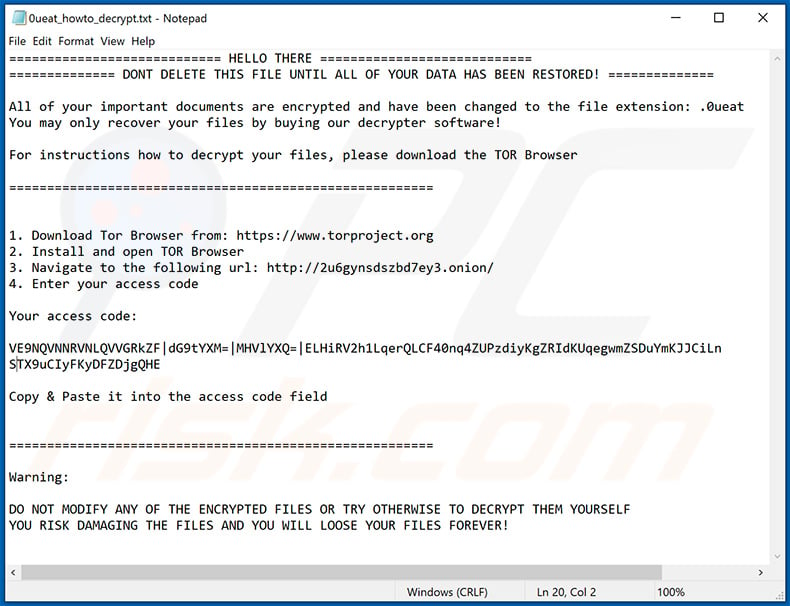
Text presented within this file:
======= HELLO THERE =======
======= DONT DELETE THIS FILE UNTIL ALL OF YOUR DATA HAS BEEN RESTORED! =======All of your important documents are encrypted and have been changed to the file extension: .0ueat
You may only recover your files by buying our decrypter software!For instructions how to decrypt your files, please download the TOR Browser
=======
1. Download Tor Browser from: hxxps://www.torproject.org
2. Install and open TOR Browser
3. Navigate to the following url: hxxp://2u6gynsdszbd7ey3.onion/
4. Enter your access codeYour access code:
-
Copy & Paste it into the access code field
=======Warning:
DO NOT MODIFY ANY OF THE ENCRYPTED FILES OR TRY OTHERWISE TO DECRYPT THEM YOURSELF
YOU RISK DAMAGING THE FILES AND YOU WILL LOOSE YOUR FILES FOREVER!
IS ransomware removal:
Instant automatic malware removal:
Manual threat removal might be a lengthy and complicated process that requires advanced IT skills. Combo Cleaner is a professional automatic malware removal tool that is recommended to get rid of malware. Download it by clicking the button below:
DOWNLOAD Combo CleanerBy downloading any software listed on this website you agree to our Privacy Policy and Terms of Use. To use full-featured product, you have to purchase a license for Combo Cleaner. 7 days free trial available. Combo Cleaner is owned and operated by RCS LT, the parent company of PCRisk.com.
Video suggesting what steps should be taken in case of a ransomware infection:
Quick menu:
- What is IS (Ordinypt) virus?
- STEP 1. Reporting ransomware to authorities.
- STEP 2. Isolating the infected device.
- STEP 3. Identifying the ransomware infection.
- STEP 4. Searching for ransomware decryption tools.
- STEP 5. Restoring files with data recovery tools.
- STEP 6. Creating data backups.
If you are a victim of a ransomware attack we recommend reporting this incident to authorities. By providing information to law enforcement agencies you will help track cybercrime and potentially assist in the prosecution of the attackers. Here's a list of authorities where you should report a ransomware attack. For the complete list of local cybersecurity centers and information on why you should report ransomware attacks, read this article.
List of local authorities where ransomware attacks should be reported (choose one depending on your residence address):
USA - Internet Crime Complaint Centre IC3
United Kingdom - Action Fraud
Spain - Policía Nacional
France - Ministère de l'Intérieur
Germany - Polizei
Italy - Polizia di Stato
The Netherlands - Politie
Poland - Policja
Portugal - Polícia Judiciária
Isolating the infected device:
Some ransomware-type infections are designed to encrypt files within external storage devices, infect them, and even spread throughout the entire local network. For this reason, it is very important to isolate the infected device (computer) as soon as possible.
Step 1: Disconnect from the internet.
The easiest way to disconnect a computer from the internet is to unplug the Ethernet cable from the motherboard, however, some devices are connected via a wireless network and for some users (especially those who are not particularly tech-savvy), disconnecting cables may seem troublesome. Therefore, you can also disconnect the system manually via Control Panel:
Navigate to the "Control Panel", click the search bar in the upper-right corner of the screen, enter "Network and Sharing Center" and select search result: 
Click the "Change adapter settings" option in the upper-left corner of the window: 
Right-click on each connection point and select "Disable". Once disabled, the system will no longer be connected to the internet. To re-enable the connection points, simply right-click again and select "Enable". 
Step 2: Unplug all storage devices.
As mentioned above, ransomware might encrypt data and infiltrate all storage devices that are connected to the computer. For this reason, all external storage devices (flash drives, portable hard drives, etc.) should be disconnected immediately, however, we strongly advise you to eject each device before disconnecting to prevent data corruption:
Navigate to "My Computer", right-click on each connected device, and select "Eject": 
Step 3: Log-out of cloud storage accounts.
Some ransomware-type might be able to hijack software that handles data stored within "the Cloud". Therefore, the data could be corrupted/encrypted. For this reason, you should log-out of all cloud storage accounts within browsers and other related software. You should also consider temporarily uninstalling the cloud-management software until the infection is completely removed.
Identify the ransomware infection:
To properly handle an infection, one must first identify it. Some ransomware infections use ransom-demand messages as an introduction (see the WALDO ransomware text file below).

This, however, is rare. In most cases, ransomware infections deliver more direct messages simply stating that data is encrypted and that victims must pay some sort of ransom. Note that ransomware-type infections typically generate messages with different file names (for example, "_readme.txt", "READ-ME.txt", "DECRYPTION_INSTRUCTIONS.txt", "DECRYPT_FILES.html", etc.). Therefore, using the name of a ransom message may seem like a good way to identify the infection. The problem is that most of these names are generic and some infections use the same names, even though the delivered messages are different and the infections themselves are unrelated. Therefore, using the message filename alone can be ineffective and even lead to permanent data loss (for example, by attempting to decrypt data using tools designed for different ransomware infections, users are likely to end up permanently damaging files and decryption will no longer be possible even with the correct tool).
Another way to identify a ransomware infection is to check the file extension, which is appended to each encrypted file. Ransomware infections are often named by the extensions they append (see files encrypted by Qewe ransomware below).

This method is only effective, however, when the appended extension is unique - many ransomware infections append a generic extension (for example, ".encrypted", ".enc", ".crypted", ".locked", etc.). In these cases, identifying ransomware by its appended extension becomes impossible.
One of the easiest and quickest ways to identify a ransomware infection is to use the ID Ransomware website. This service supports most existing ransomware infections. Victims simply upload a ransom message and/or one encrypted file (we advise you to upload both if possible).

The ransomware will be identified within seconds and you will be provided with various details, such as the name of the malware family to which the infection belongs, whether it is decryptable, and so on.
Example 1 (Qewe [Stop/Djvu] ransomware):

Example 2 (.iso [Phobos] ransomware):

If your data happens to be encrypted by ransomware that is not supported by ID Ransomware, you can always try searching the internet by using certain keywords (for example, a ransom message title, file extension, provided contact emails, crypto wallet addresses, etc.).
Search for ransomware decryption tools:
Encryption algorithms used by most ransomware-type infections are extremely sophisticated and, if the encryption is performed properly, only the developer is capable of restoring data. This is because decryption requires a specific key, which is generated during the encryption. Restoring data without the key is impossible. In most cases, cybercriminals store keys on a remote server, rather than using the infected machine as a host. Dharma (CrySis), Phobos, and other families of high-end ransomware infections are virtually flawless, and thus restoring data encrypted without the developers' involvement is simply impossible. Despite this, there are dozens of ransomware-type infections that are poorly developed and contain a number of flaws (for example, the use of identical encryption/decryption keys for each victim, keys stored locally, etc.). Therefore, always check for available decryption tools for any ransomware that infiltrates your computer.
Finding the correct decryption tool on the internet can be very frustrating. For this reason, we recommend that you use the No More Ransom Project and this is where identifying the ransomware infection is useful. The No More Ransom Project website contains a "Decryption Tools" section with a search bar. Enter the name of the identified ransomware, and all available decryptors (if there are any) will be listed.

Restore files with data recovery tools:
Depending on the situation (quality of ransomware infection, type of encryption algorithm used, etc.), restoring data with certain third-party tools might be possible. Therefore, we advise you to use the Recuva tool developed by CCleaner. This tool supports over a thousand data types (graphics, video, audio, documents, etc.) and it is very intuitive (little knowledge is necessary to recover data). In addition, the recovery feature is completely free.
Step 1: Perform a scan.
Run the Recuva application and follow the wizard. You will be prompted with several windows allowing you to choose what file types to look for, which locations should be scanned, etc. All you need to do is select the options you're looking for and start the scan. We advise you to enable the "Deep Scan" before starting, otherwise, the application's scanning capabilities will be restricted.

Wait for Recuva to complete the scan. The scanning duration depends on the volume of files (both in quantity and size) that you are scanning (for example, several hundred gigabytes could take over an hour to scan). Therefore, be patient during the scanning process. We also advise against modifying or deleting existing files, since this might interfere with the scan. If you add additional data (for example, downloading files/content) while scanning, this will prolong the process:

Step 2: Recover data.
Once the process is complete, select the folders/files you wish to restore and simply click "Recover". Note that some free space on your storage drive is necessary to restore data:

Create data backups:
Proper file management and creating backups is essential for data security. Therefore, always be very careful and think ahead.
Partition management: We recommend that you store your data in multiple partitions and avoid storing important files within the partition that contains the entire operating system. If you fall into a situation whereby you cannot boot the system and are forced to format the disk on which the operating system is installed (in most cases, this is where malware infections hide), you will lose all data stored within that drive. This is the advantage of having multiple partitions: if you have the entire storage device assigned to a single partition, you will be forced to delete everything, however, creating multiple partitions and allocating the data properly allows you to prevent such problems. You can easily format a single partition without affecting the others - therefore, one will be cleaned and the others will remain untouched, and your data will be saved. Managing partitions is quite simple and you can find all the necessary information on Microsoft's documentation web page.
Data backups: One of the most reliable backup methods is to use an external storage device and keep it unplugged. Copy your data to an external hard drive, flash (thumb) drive, SSD, HDD, or any other storage device, unplug it and store it in a dry place away from the sun and extreme temperatures. This method is, however, quite inefficient, since data backups and updates need to be made regularly. You can also use a cloud service or remote server. Here, an internet connection is required and there is always the chance of a security breach, although it's a really rare occasion.
We recommend using Microsoft OneDrive for backing up your files. OneDrive lets you store your personal files and data in the cloud, sync files across computers and mobile devices, allowing you to access and edit your files from all of your Windows devices. OneDrive lets you save, share and preview files, access download history, move, delete, and rename files, as well as create new folders, and much more.
You can back up your most important folders and files on your PC (your Desktop, Documents, and Pictures folders). Some of OneDrive’s more notable features include file versioning, which keeps older versions of files for up to 30 days. OneDrive features a recycling bin in which all of your deleted files are stored for a limited time. Deleted files are not counted as part of the user’s allocation.
The service is built using HTML5 technologies and allows you to upload files up to 300 MB via drag and drop into the web browser or up to 10 GB via the OneDrive desktop application. With OneDrive, you can download entire folders as a single ZIP file with up to 10,000 files, although it can’t exceed 15 GB per single download.
OneDrive comes with 5 GB of free storage out of the box, with an additional 100 GB, 1 TB, and 6 TB storage options available for a subscription-based fee. You can get one of these storage plans by either purchasing additional storage separately or with Office 365 subscription.
Creating a data backup:
The backup process is the same for all file types and folders. Here’s how you can back up your files using Microsoft OneDrive
Step 1: Choose the files/folders you want to backup.

Click the OneDrive cloud icon to open the OneDrive menu. While in this menu, you can customize your file backup settings.

Click Help & Settings and then select Settings from the drop-down menu.

Go to the Backup tab and click Manage backup.

In this menu, you can choose to backup the Desktop and all of the files on it, and Documents and Pictures folders, again, with all of the files in them. Click Start backup.
Now, when you add a file or folder in the Desktop and Documents and Pictures folders, they will be automatically backed up on OneDrive.
To add folders and files, not in the locations shown above, you have to add them manually.

Open File Explorer and navigate to the location of the folder/file you want to backup. Select the item, right-click it, and click Copy.

Then, navigate to OneDrive, right-click anywhere in the window and click Paste. Alternatively, you can just drag and drop a file into OneDrive. OneDrive will automatically create a backup of the folder/file.

All of the files added to the OneDrive folder are backed up in the cloud automatically. The green circle with the checkmark in it indicates that the file is available both locally and on OneDrive and that the file version is the same on both. The blue cloud icon indicates that the file has not been synced and is available only on OneDrive. The sync icon indicates that the file is currently syncing.

To access files only located on OneDrive online, go to the Help & Settings drop-down menu and select View online.

Step 2: Restore corrupted files.
OneDrive makes sure that the files stay in sync, so the version of the file on the computer is the same version on the cloud. However, if ransomware has encrypted your files, you can take advantage of OneDrive’s Version history feature that will allow you to restore the file versions prior to encryption.
Microsoft 365 has a ransomware detection feature that notifies you when your OneDrive files have been attacked and guide you through the process of restoring your files. It must be noted, however, that if you don’t have a paid Microsoft 365 subscription, you only get one detection and file recovery for free.
If your OneDrive files get deleted, corrupted, or infected by malware, you can restore your entire OneDrive to a previous state. Here’s how you can restore your entire OneDrive:

1. If you're signed in with a personal account, click the Settings cog at the top of the page. Then, click Options and select Restore your OneDrive.
If you're signed in with a work or school account, click the Settings cog at the top of the page. Then, click Restore your OneDrive.
2. On the Restore your OneDrive page, select a date from the drop-down list. Note that if you're restoring your files after automatic ransomware detection, a restore date will be selected for you.
3. After configuring all of the file restoration options, click Restore to undo all the activities you selected.
The best way to avoid damage from ransomware infections is to maintain regular up-to-date backups.
Share:

Tomas Meskauskas
Expert security researcher, professional malware analyst
I am passionate about computer security and technology. I have an experience of over 10 years working in various companies related to computer technical issue solving and Internet security. I have been working as an author and editor for pcrisk.com since 2010. Follow me on Twitter and LinkedIn to stay informed about the latest online security threats.
PCrisk security portal is brought by a company RCS LT.
Joined forces of security researchers help educate computer users about the latest online security threats. More information about the company RCS LT.
Our malware removal guides are free. However, if you want to support us you can send us a donation.
DonatePCrisk security portal is brought by a company RCS LT.
Joined forces of security researchers help educate computer users about the latest online security threats. More information about the company RCS LT.
Our malware removal guides are free. However, if you want to support us you can send us a donation.
Donate
▼ Show Discussion